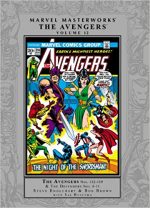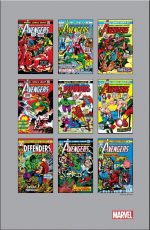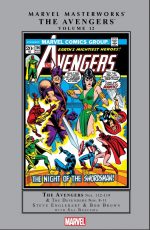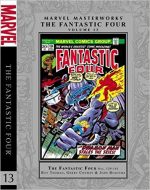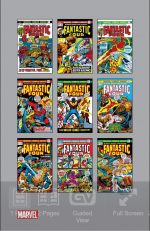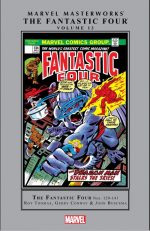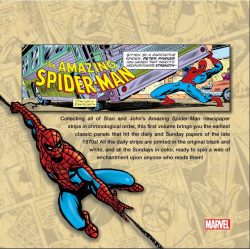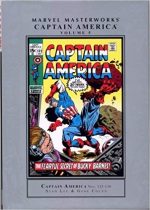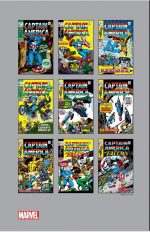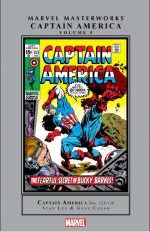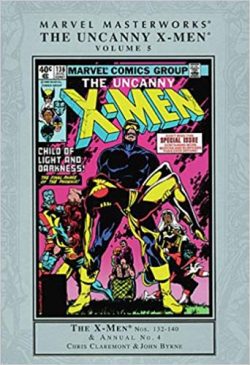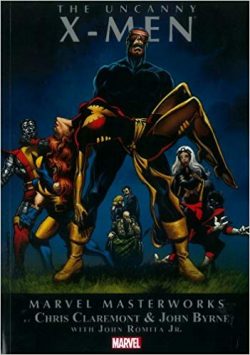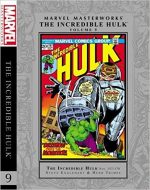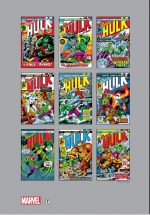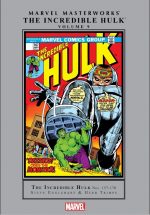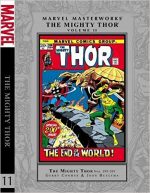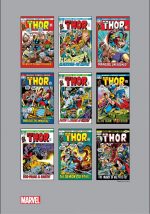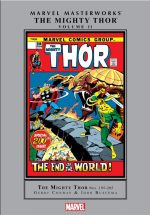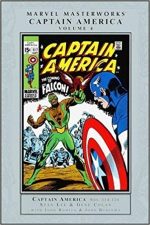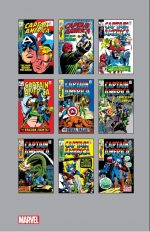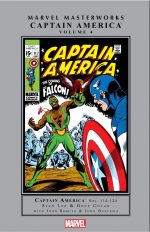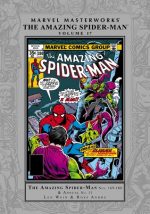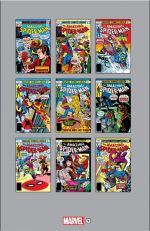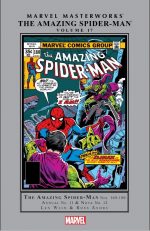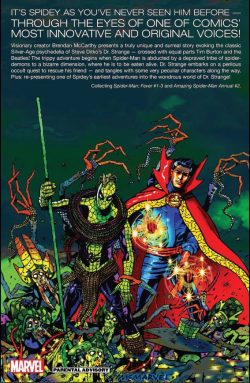
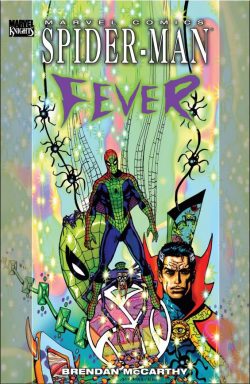
By Brendan McCarthy & Steve Cook, with Stan Lee & Steve Ditko (Marvel)
ISBN: 987-0-7851-4125-9 (TPB)
Peter Parker was a smart, alienated kid when he was bitten by a radioactive spider during a school trip. Developing astonishing abilities – augmented with his own natural chemistry, physics and engineering genius – the boy did what any lonely, unappreciated, geeky nerd would do with such newfound prowess: try to cash in for girls, fame and money…
Hiding behind a home-made costume (in case he fails and makes a fool of himself), Parker becomes a minor media celebrity – and a criminally self-important one. To his eternal regret, when a thief flees past him one night, the cocky teen doesn’t lift a finger to stop him. When the boy returns home that night, he learns that his beloved guardian uncle Ben Parker has been murdered.
Crazed with a need for vengeance, Peter hunts the assailant who made his devoted Aunt May a widow and killed the only father he had ever known, and discovers, to his horror, that it is the self-same felon he neglected to stop. The traumatised boy is fixated on the fact that his irresponsibility resulted in the death of the man who raised him, and swears to forevermore use his powers to help others…
Since that night he has tirelessly battled miscreants, monsters and madmen, with a fickle, ungrateful public usually baying for his blood even as he perpetually saves them…
It wasn’t too long after his spectacular launch that Stan Lee & Steve Ditko’s astonishing Spider-Man proved himself a contemporary hero who fitted every possible milieu and scenario; equally at home against cheap hoods, world-busting super-menaces or the oddest of alien incursions, and this superbly outré modern masterpiece – available in trade paperback and digital formats – celebrates that astounding versatility by reprising one of the most brilliantly bizarre team-ups from the early Marvel Age.
The legendary classic first meeting of Mystic Master and Wondrous Wallcrawler occurred in Amazing Spider-Man Annual #2 and it’s rightly included at the end of this beguiling tome featuring über-imaginatively narrative art trendsetter Brendan McCarthy’s tribute to Ditko’s dazzling graphic magic.
London-born McCarthy came to prominence in comics on 2000AD before branching out into international comics stardom whilst pursuing parallel careers in film, television and design. His most notable works range from Strange Days and Paradax to Judge Dredd, The Zaucer of Zilk, Zenith, Skin, Rogan Gosh, Dream Gang and innumerable stunning covers. His moving media credits include The Storyteller, Highlander, Lost in Space, Reboot, Mad Max 4: Fury Road and so much more.
Collected here is a digitally-psychedelic, intoxicatingly appealing 3-issue miniseries from 2010 and produced for the mature-audience Marvel Knights sub-imprint. Written and illustrated by McCarthy with lettering and additional colouring from old comrade Steve Cook, it begins with the web-spinner battling frequent flyer archfoe The Vulture even as Sorcerer Supreme Stephen Strange explores a few Outer Realms and inadvertently activates an ancient trap set in an old grimoire – the Lost Journal of Albion Crowley…
The “webwaze†energy escapes into the very architecture and infrastructure of New York City, finding its way to the cornered Vulture: possessing the bad old bird before passing through him, permeating and infecting the Friendly Neighbourhooded one…
When Strange further examines the cursed chronicle, he discovers the sorry tale of Crowley and his unlucky acolyte Victor Neumenon, whose long ago trans-dimensional forays led them into fateful contact with cosmically peripheral spider-demons dubbed Arachnix, lurking in the darkest corners and crannies of Creation.
Both were subjected to unimaginable atrocity at the many hands of the hairy horrors, but only Crowley returned to recount his experiences, and spin their adventures his way…
Meanwhile, ensorcelled Spider-Man, reeling in delirious torment, has instinctively crawled into the bathroom of Strange’s Sanctum Sanctorum where his now-tainted soul is suddenly snatched away by arcane Arachnix-Hunter Daddy Longlegs, who drags the essence of the hero to its hideous homelands to be devoured by the ghastly King Korazon…
Arriving too late to assist, the Master of the Mystic Arts gives chase through increasingly impossible planes of existence, following the ethereal webwaze paths in his frenzied attempts to save his old friend from utter horror and eternal damnation…
Along the way the wizard meets keenly helpful void-dwellers Fetch Doggy Fetch and Pugly, even as Peter Parker’s enmeshed spirit faces consumption by the Eight-Legged Tribe. Somehow, however, the hero’s dual nature confounds the beasts. They cannot determine if he is Spider – and therefore kin – or Man, and thus the most appealing meal ever presented to any Arachnix…
To decide his prey’s future fate Korazon despatches the befuddled soul-shell through the Insect Gate to catch the fabled feast known as the Sorror-Fly from the home dimension of all arthropods. If the arbitrary man-spider can snare the elusive treat he is their brother, but if he returns empty-handed, he’s just lunch…
Whilst the englamoured hero hunts in the insect realm, Strange rescues fellow Earth-born traveller Ms. Ningirril, long-trapped during her own dimensional Walkabout. In gratitude, the Antipodean wanderer provides the mage with useful intelligence, sound advice and a safer, swifter means of navigating his search for Spider-Man…
In a fantastic City of Termites our befuddled hero has succeeded in his task and is dragging the woeful Sorror-Fly back to the Arachnix: further succumbing with each passing moment to the inexorable, bestial allure of his Spider side, even as his garrulous meal relates the dread history of the insect dimension and a prophecy of telling magnitude.
When the Sorcerer Supreme and his allies fortuitously arrive, the Fly transforms back to a form he has not held for over a century, presaging the redemption and cure of the fallen Wall-crawler and a spectacular end to an infinitude of eight-legged terrors…
Bold, ambitious and visually compelling and off the wall, this superb magical mystery tour is perfectly augmented here by that aforementioned first meeting…
In 1965 Steve Ditko was blowing away audiences with another oddly tangential, daringly different superhero. Amazing Spider-Man King Size Annual #2 revealed ‘The Wondrous World of Dr. Strange!’: introducing the webslinger to other realities after he accidentally interrupts an attack by wannabe wizard Xandu upon the Master of the Mystic Arts.
The villain had stolen the puissant Wand of Watoomb from Strange to achieve ultimate power, and when that pesky, interfering Spider-Man butts in, the power-crazed dilettante exiles him to an alien dimension – but not before the hero’s webbing snatches the arcane artefact from Xandu’s hand and takes it with him…
Cue an involuntary incredible journey to phantasmagorical, mind-bending worlds pursued by unstoppable zombie slaves and a desperately determined Doctor Strange in a dimension-hopping masterpiece of mystery and imagination…
Moody, creepy and staggeringly engrossing, this eerie eldritch escapade also includes the author/artist’s ‘Notes on the Design and Story Ideas for Spider-Man: Fever’ – a selection of commentary, roughs and sketches offering a fascinating glimpse of into the creative process of a truly unique talent, as well as a selection of Ditko pinups detailing the M.O.’s of The Circus of Crime, The Scorpion, The Beetle, Jonah’s Robot and the Crime-Master…
Here’s another superb and crucial selection starring the timeless teen icon, superhero symbol and big screen superstar fans just cannot afford to do without
© 1965 and 2017 Marvel Characters, Inc. All rights reserved.

